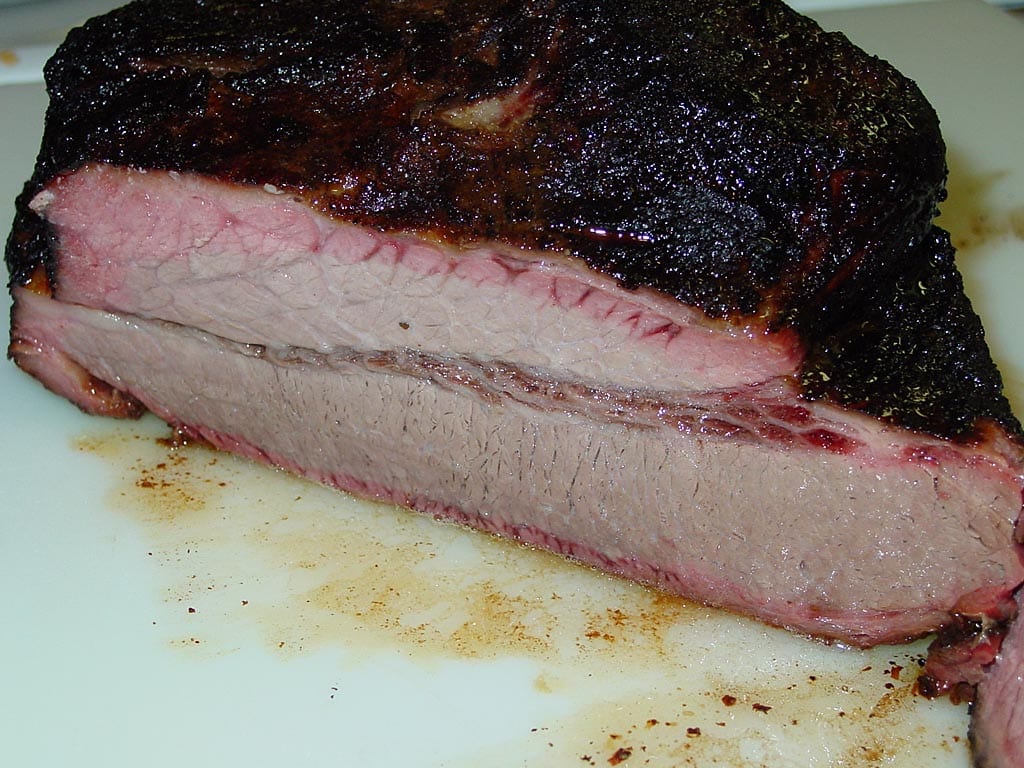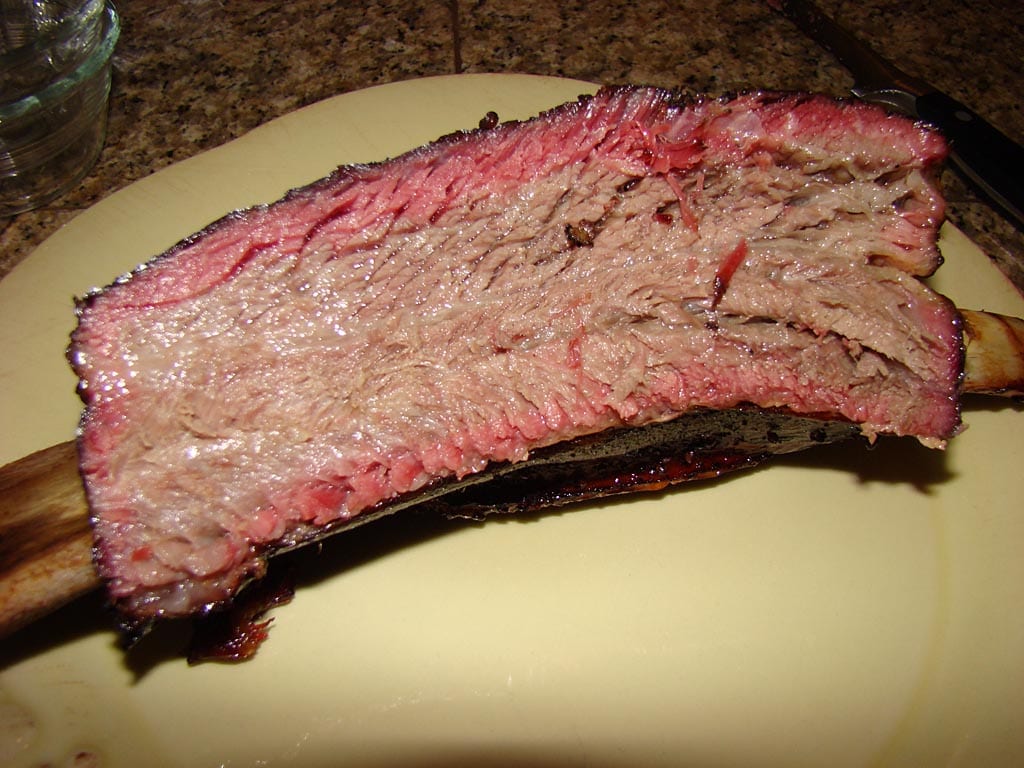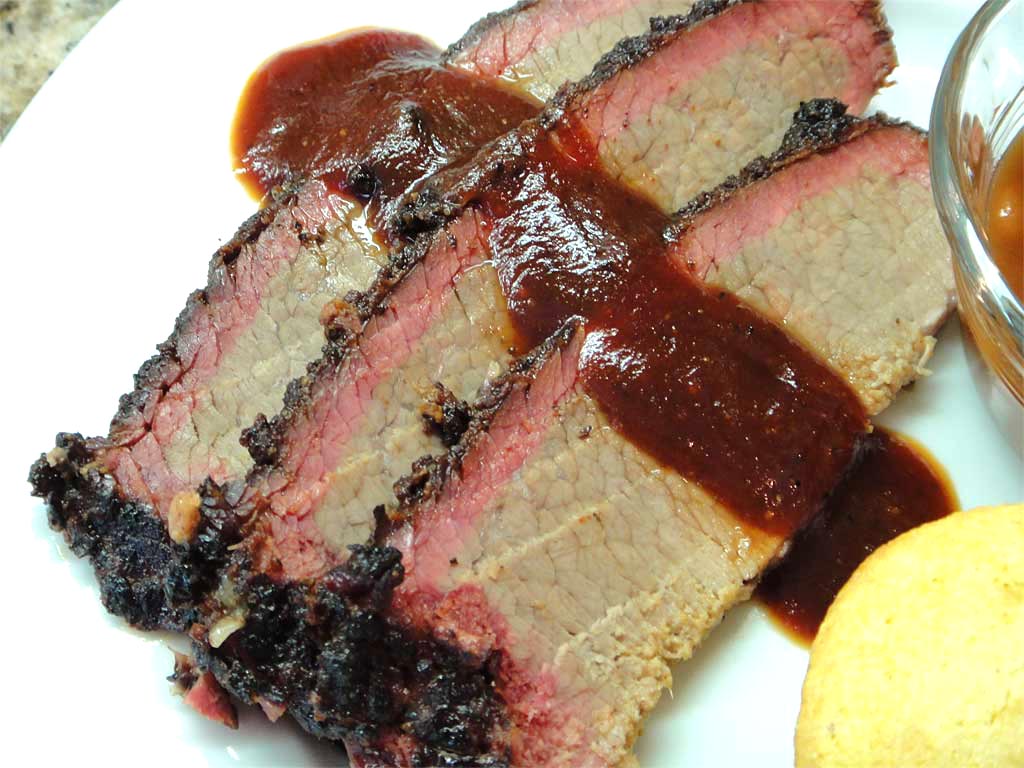You’ll find some long-winded dissertations about the smoke ring on the Internet. This article is not one of them. Here are the basic facts you need to know about the smoke ring.
What is the smoke ring?
It’s that pink layer, 1/8″ to 1/2″ wide, just below the surface of the meat. It’s most pronounced in beef and pork, less so in poultry.
What causes the smoke ring?
Wood and charcoal give off many gasses when burned, including nitric oxide (NO) and carbon monoxide (CO). These two gasses interact with a protein in meat called myoglobin to produce the pink color, not the visible smoke you see coming out of the smoker.
Does good barbecue need a smoke ring? Does it add flavor to the meat, or is it just for looks?
Barbecue does not need a smoke ring to be moist, tender and delicious. The smoke ring adds no flavor to the meat, but a good, strong smoke ring is sexy and it’s the look that many people have come to expect from barbecued meats, especially brisket and pork. Interestingly, in many barbecue competitions, the judges are specifically instructed to ignore the smoke ring when judging meat for appearance because it can be produced chemically using curing agents.
How does moisture and the use of a water pan or spritzing meat affect smoke ring formation?
In order for NO and CO to interact with myoglobin, they must dissolve into surface moisture on the meat. Keeping the meat surface moist is one way to promote smoke ring formation. Using water in the pan of the Weber Smokey Mountain Cooker is one way to create surface moisture on meat. Spraying the meat occasionally with water or other flavorful liquids is another way to keep the surface moist. Just don’t spray too early or you’ll wash the rub off the meat—wait for the crust to setup on the meat before spritzing.
At what internal meat temperature does the smoke ring stop developing?
It is commonly thought that 140°F is the temperature at which the smoke ring stops developing in beef. However, the website AmazingRibs.com states that smoke ring development stops at 170°F because that’s the temperature at which myboglobin breaks down in beef and loses its ability to react with NO and CO. It’s not clear if 170°F also applies to pork and poultry, but it is clear that smoke ring formation is arrested in all meats at some point.
Why is the smoke ring just on the outside edge of the meat?
Because the dissolved NO and CO cannot penetrate deeply into the meat. As a result, they react with myoglobin only within the first 1/8″ to 1/2″ of the surface.
Can NO and CO penetrate fat to create a smoke ring?
NO and CO can penetrate only the thinnest layers of fat to react with myoglobin in the underlying meat. Since there’s no myoglobin in fat, it won’t turn pink when exposed to NO and CO. You’re unlikely to get a smoke ring on parts of a brisket covered with the typical 1/8″ – 1/4″ of fat that most people leave on the meat.
Which cooking method results in the best smoke ring: “low & slow” or “hot & fast”?
In theory, “low & slow” cooking should result in a better smoke ring than “hot & fast” cooking. Keeping the internal temperature of meat lower for a longer period of time, while also keeping the surface moist, should allow more time for interaction between myoglobin, NO and CO to create a better smoke ring. But given all the variables at play—the type of meat and its unique characteristics, the type of fuel and how hot it burns, the type of smoke wood and whether it’s green or well-seasoned, and the humidity level in the cooker—it’s hard to offer a definitive answer to this question. In fact, the beautiful smoke ring you see in the sliced brisket photo above was achieved with “hot & fast” cooking, and it’s as nice as any smoke ring I’ve gotten on “low & slow” briskets.
Can the smoke ring be enhanced by barbecuing cold meat straight from the refrigerator?
Yes, for the same reason described in the “low & slow” cooking question above…maintaining a lower internal meat temperature for a longer period of time, while also keeping the surface moist, should allow more time for interaction between myoglobin, NO and CO to create a better smoke ring. The disclaimer about “variables at play” also apply here.
Can a smoke ring be achieved by adding ingredients to a rub or by applying an additive to the meat?
Ground celery seed is a common ingredient added to rubs that is known to create/enhance a smoke ring. Adding 1 teaspoon of ground celery seed to any rub recipe should make an obvious difference in smoke ring.
Sprinkling meat with a curing agent like Morton Tender Quick or Prague Powder #1 will also produce a smoke ring. These products contain sodium nitrite, and the nitrite reacts with myoglobin similar to the way NO does from a wood or charcoal fire.
Can a smoke ring be achieved using a propane or electric smoker?
Propane produces CO but very little NO when burned, and an electric element produces no NO or CO. This explains why at some point you may have seen a small smoke ring on meats cooked in a gas grill. But in general, you must use wood chips, chunks or pellets and keep the surface of the meat moist during cooking to produce a smoke ring in a propane or electric smoker.
Does the smoke ring indicate that meat is undercooked?
No. This is a common misconception among people unfamiliar with barbecue. Many a barbecue restaurant has had to post signs stating that the pink smoke ring has nothing to do with the meat’s doneness, rather it’s a sign that the meat has been cooked in the presence of smoke, which is a simplistic explanation but reassuring to most diners.










